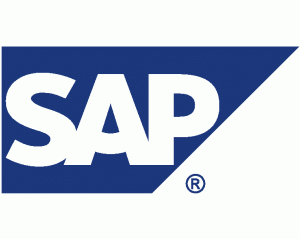SAP gives startups millions of dollars worth of software. Here’s why.
Spend any time at SAP‘s headquarters in Silicon Valley and you’ll hear the name “HANA” spoken in hushed and reverential tones by flip-flop wearing engineers and buttoned-up executives alike. HANA is fast, expensive, and touted as one of the most exciting developments in years.
Hana is not a beautiful woman or flashy car. “HANA” (which stands for High-Performance Analytic Appliance) is a container that can store up to 500 terabytes of data, and execute at high speed.
SAP’s executives will tell you that HANA is the software behemoth’s answer to the “big data” trend, and last quarter it generated $106 million in revenue, putting SAP on track to meet full-year expectations of at least $400 million.
“Innovation in data management has stagnated,” said Amit Sinha, the head of database and technology product marketing for SAP. Sinha said that he foresees a $2 trillion market opportunity for HANA and related database management technologies in the SAP suite.
As you would expect from SAP, which counts Oracle as its major competitor, HANA’s customers are brand-name companies with million dollar IT budgets, such as Deloitte, Adobe, Cisco Systems, and consumer-products giant Proctor & Gamble.
Reality vs. Expectations
SAP should have been able to play the game it always does: selling its database technology to customers with mammoth IT budgets. But reports increasingly show that HANA has not met industry expectations. As Irregular Enterprise writer Dennis Howlett inferred in a recent column:
“Once early adopters got over the speed shock, they quickly settled into ‘so what?’ mode. SAP is now at an inflection point where it has to figure out what to do with HANA beyond speeds and feeds.”
That time is now. SAP may have hit on the real use for HANA.
The SAP Startup Program
HANA’s customers also include Taulia and Zettaset. Haven’t heard of them? They are fast-growing enterprise IT startups, and they are among the dozen handpicked by SAP to develop their applications on HANA for free.
It’s has been about a year since the “SAP Startup Focus” program launched, and it has recently extended its network to Ireland and India. Here’s how the program works: SAP selects early-stage enterprise and IT companies that are applying predictive analytics to a specific problem or vertical, like supply chain management or retail inventory. They receive HANA, advice, and mentorship from SAP executives. Graduates of SAP’s startup program include Host Analytics, Retailigence, FusionOps (an SAP partner), Optessa, and iSky.
With this effort, SAP is following in Microsoft’s footsteps. Microsoft’s BizSpark program provides startups with free software tools in an effort to build loyalty early in a companies’ life cycle. Robin Meyerhoff, an SAP spokesperson, said that the company’s strategy is similar and involves “spurring SAP HANA adoption much like most other platform companies do.”
But SAP isn’t offering the gift of Outlook or Powerpoint: It’s giving away software that’s worth millions of dollars.
So what’s in it for SAP?
At a recent SAP innovation conference, Jason Yotopolous, the executive vice president of global research and business incubation at SAP, hinted at the company’s reasoning. “We are building startups within SAP,” he said, and he added that they work in a “co-innovation fashion” with these companies. “Innovation is a challenge within a big company,” he admitted.
Next to take the stage were partners from SAP Ventures, the venture arm (with SAP as its sole LP) that has poured funds into portfolio companies across the enterprise landscape. Notable investments include cloud storage provider Box; Endeca, an enterprise search vendor acquired by Oracle; and flash storage company Violin Memory.
It should come as no surprise that SAP Ventures recently announced that it would set aside $155 million to fund startups initiated into the program.
“SAP is betting big on big data,” said Sinha in an interview with VentureBeat. “We are always looking for startups invest in and potentially to acquire.”
I spoke with SAP Ventures’ new COO and managing director, Elizabeth Clarkson, who said that the venture firm is autonomous and independent, but admitted that they are “always trying to figure out which ones [from the program] we might fund.”
Is it all starting to come together?
If SAP isn’t going to produce the innovations of the decade in-house, it sure better get behind the startups that are.
It’s not just about building loyalty with early-stage companies before they grow and are flooded with options such as IBM and Oracle. It’s about ensuring SAP has an equity stake and, when the timing is right, that it can make the first stab at acquisition.
As co-CEO Jim Hagemann Snabe hinted in a recent interview with Germany newspaper Suddeutsche Zeitung, an aggressive acquisition strategy is part of SAP’s DNA. ””Our long-term growth should be made up of two-thirds by organic strength and one-third by acquisitions,” he said.
The SAP acquisition trail has showed no signs of coming to a halt: the company picked up SuccessFactors for $3.4 billion, and it purchased Ariba, a business software management company, for $4.3 billion.
Joe Hyland, the marketing lead for Taulia, a startup that uses HANA to learn new ways companies can save money in the supply chain process, explains: “Giving startups HANA for free is a wise investment.” Taulia, a San Francisco-based company founded in 2009, was selected for the current batch of startups to receive free software. It is now partnered with SAP.
The relationship is a two-way street; many of these startups will also receive access to SAP’s network of household-name customers. It can be a major stumbling block for early-stage enterprise companies to gain traction. Typically, they have to adopt a “fake it till you make it” approach. Like Taulia, many of these startups now consider themselves “SAP partners” and reap the benefits.
SAP has hit on another compelling use for HANA. This summer, it announced that the startup program has been such a success that it will begin offering developers free access to HANA and make it available on Amazon Web Services. (Note: You will still have to pay for AWS usage.)
Meyerhoff, a member of the communications team for SAP, told me that the end goal is to “launch a revenue share model for productive use,” meaning that SAP will take a cut once the company launches a product.
“We do not buy market share. We buy the future.”
HANA is a database tool that is a bit faster than most, but is expensive to access and deploy. Through smart tactics, it gave SAP an opportunity to get its foot in the door with developers that are building the next wave of technologies for the enterprise.
It became clear during my time at SAP that the strategy was railroaded from above by the highest echelons of the company: the board. “Four years ago, people were suspending belief,” Yotopolous explained. ”Now, we are driving some compelling revenue, we’ve been recognized by the board of directors, and are starting to scale that up. The sky is the limit”
According to SAP, acquisitions are the only way to innovate and make progress in new areas of business. The startup program is a brilliant move, and ensures that SAP is firmly in the running to snap up the most promising startups when the timing is right. ”We do not buy market share”, said Snabe in an interview with Suddeutsche Zeitung. “We buy the future.”
This article originally appeared on Venture Beat
About the Author
Christina Farr is a writer at VentureBeat covering enterprise, education technology, venture, and startup culture.
Prior to moving to the Bay Area, Christina was a writer and editor in London. Her work has been published in a variety of technology and local news publications, including VentureBeat, TheNextWeb (TNW), The San Francisco Chronicle, The Bay Citizen, and Digital Trends.
Editorial aside, Christina has experience working with B2B and consumer tech companies in a public relations, marketing and business development capacity.










